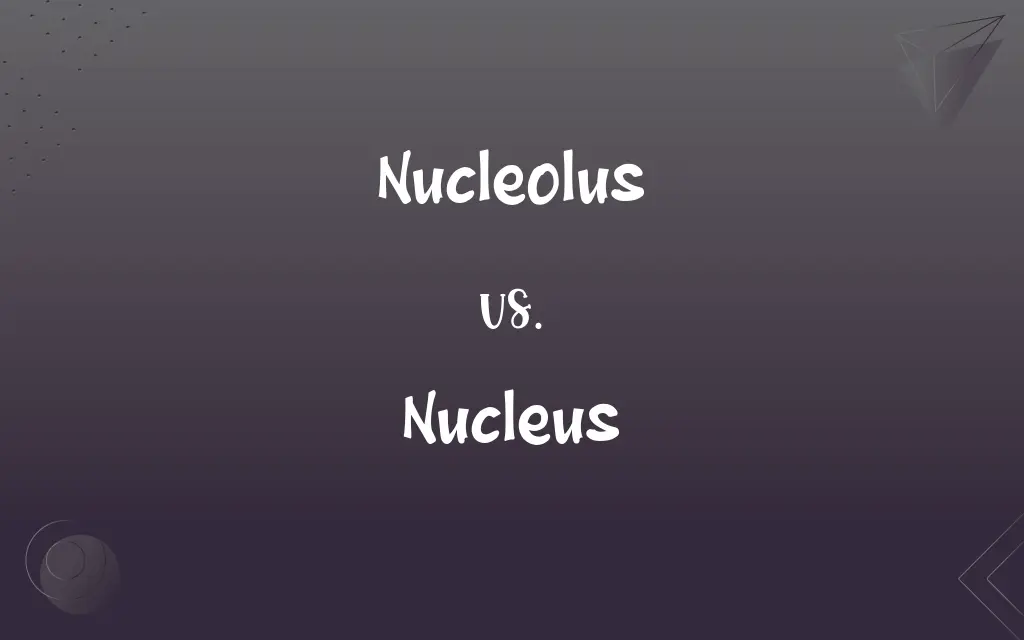Nucleolus vs. Nucleus: What's the Difference?
Edited by Aimie Carlson || By Janet White || Published on November 30, 2023
The nucleolus is a dense region within the nucleus of a cell, involved in ribosome production; the nucleus is the cell's central organelle, containing genetic material.

Key Differences
The nucleus is a membrane-bound organelle found in eukaryotic cells, housing the cell’s genetic material in the form of DNA. The nucleolus, located within the nucleus, is a distinct, dense structure primarily involved in the synthesis of ribosomes.
Functionally, the nucleus serves as the control center of the cell, regulating gene expression and cell growth. The nucleolus, meanwhile, specifically focuses on assembling ribosomal subunits from rRNA and proteins.
In terms of physical structure, the nucleus is surrounded by a double membrane known as the nuclear envelope, which separates it from the cytoplasm. The nucleolus, on the other hand, is not membrane-bound and is formed around specific chromosomal regions.
The size and number of nucleoli can vary depending on the cell’s activity; cells with high protein synthesis rates often have larger and more numerous nucleoli. The nucleus, consistent in structure, contains other important components like chromatin and the nucleoplasm.
In the context of cell division, the nucleus undergoes significant changes, eventually dividing during mitosis. The nucleolus, however, disassembles during cell division and reassembles in the daughter cells’ nuclei.
ADVERTISEMENT
Comparison Chart
Function
Production of ribosomes
Control center of the cell, housing genetic material
Location
Inside the nucleus
Central part of a cell
Structure
Not membrane-bound, dense region
Surrounded by a double membrane, the nuclear envelope
Relation to Cell Activity
Size and number vary with protein synthesis rate
Consistent structure, central to all cell activities
Behavior During Cell Division
Disassembles and reassembles
Divides
ADVERTISEMENT
Nucleolus and Nucleus Definitions
Nucleolus
The nucleolus is a dense structure in the nucleus producing ribosomes.
Active cells often have prominent nucleoli due to their high ribosome production.
Nucleus
The nucleus is a cell's central organelle containing its genetic material.
The nucleus directs cellular activities based on the information in its DNA.
Nucleolus
It forms around chromosomal regions that contain rRNA genes.
The nucleolus's location correlates with the cell’s demand for ribosomes.
Nucleus
The nucleus regulates gene expression and cell growth.
Mutations in the nucleus can lead to uncontrolled cell growth, as seen in cancers.
Nucleolus
It assembles ribosomal subunits from rRNA and proteins.
The nucleolus is essential for synthesizing the machinery needed for protein synthesis.
Nucleus
The nucleus divides during cell division, distributing genetic material.
During mitosis, the nucleus divides to ensure each daughter cell receives identical genetic material.
Nucleolus
The nucleolus is not membrane-bound, differing from most organelles.
Being non-membranous, the nucleolus can rapidly change in size and shape.
Nucleus
It's surrounded by a nuclear envelope that separates it from the cytoplasm.
The nuclear envelope maintains the distinct environment of the nucleus.
Nucleolus
A small body in the nucleus of a cell that contains protein and RNA and is the site for the synthesis of ribosomal RNA and for the formation of ribosomal subunits.
Nucleus
It contains chromatin and the nucleoplasm, apart from the nucleolus.
Chromatin within the nucleus is a complex of DNA and proteins, crucial for genetic function.
Nucleolus
(cytology) A conspicuous, rounded body within the nucleus of a cell.
Nucleus
A central or essential part around which other parts are gathered or grouped; a core
The nucleus of a city.
Nucleolus
A little nucleus.
Nucleus
Something regarded as a basis for future development and growth; a kernel
A few paintings that formed the nucleus of a great art collection.
Nucleolus
A small rounded body contained in the nucleus of a cell or a protozoan.
Nucleolus
A small round body of protein in a cell nucleus; nucleoli contain RNA and are involved in protein synthesis
Nucleolus
The nucleolus disassembles during mitosis and reassembles afterward.
During cell division, the nucleolus temporarily disappears and then reforms in new cells.
FAQs
Does the nucleolus contain DNA?
Yes, it contains rRNA genes, part of the DNA.
What's the role of the nucleolus in protein synthesis?
It assembles ribosomal subunits, crucial for protein synthesis.
How is the nucleus separated from the cell cytoplasm?
By a double-layered membrane called the nuclear envelope.
What happens to the nucleolus during cell division?
It disassembles and reassembles in the daughter cells.
Can a cell have multiple nucleoli?
Yes, cells with high protein synthesis may have several nucleoli.
Is the nucleus visible under a light microscope?
Yes, it’s typically visible as a large, dark spot.
How does the size of the nucleolus relate to cell activity?
Higher protein synthesis demands result in a larger nucleolus.
What is the nucleolus?
It’s a dense area in the nucleus responsible for ribosome production.
What is the function of the nucleus?
The nucleus controls cell activities and stores genetic material.
What structures are found in the nucleus?
It contains DNA, chromatin, nucleoplasm, and the nucleolus.
How does the nuclear envelope function?
It regulates the exchange of materials between the nucleus and cytoplasm.
Does the nucleolus have a membrane?
No, it’s a non-membranous structure.
What genetic material is in the nucleus?
It contains chromosomal DNA.
Can cells function without a nucleus?
Most cells cannot function properly without a nucleus, except mature red blood cells.
What is the importance of the nucleus in cell division?
It ensures genetic material is accurately divided into daughter cells.
Can the nucleolus be affected by cellular stress?
Yes, stress can alter its size and function.
How does the nucleolus contribute to cellular aging?
Changes in nucleolar function can be indicators of aging processes in cells.
What is the nucleoplasm?
It's the gel-like substance within the nucleus.
How does the nucleus affect gene expression?
It regulates which genes are turned on or off.
What is the relationship between the nucleus and cancer?
Changes in nuclear DNA can lead to uncontrolled cell growth, a hallmark of cancer.
About Author
Written by
Janet WhiteJanet White has been an esteemed writer and blogger for Difference Wiki. Holding a Master's degree in Science and Medical Journalism from the prestigious Boston University, she has consistently demonstrated her expertise and passion for her field. When she's not immersed in her work, Janet relishes her time exercising, delving into a good book, and cherishing moments with friends and family.
Edited by
Aimie CarlsonAimie Carlson, holding a master's degree in English literature, is a fervent English language enthusiast. She lends her writing talents to Difference Wiki, a prominent website that specializes in comparisons, offering readers insightful analyses that both captivate and inform.

































































